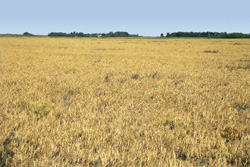
News
Tiny capsules with big potential
Researchers aim to deliver droplets of flax oil into functional foods.
March 5, 2008 By Carolyn King
One of the latest value added opportunities for food-grade flax is coming in a very small package. Researchers in the University of Saskatchewan’s Food and Bioproduct Sciences Department are developing technology to create microcapsules made of pea and canola protein. The microcapsules are designed to hold droplets of flax oil, keeping the oil tasty and wholesome when added to food products. This technology could open the door to a high value market for prairie flax, canola and pea growers and processors.
“The idea behind this project is to develop a delivery system for carrying heart-healthy essential fatty acids from flax oil. The protein capsules provide protection during manufacture and storage of the food products, so we can actually deliver the fatty acids as functional food ingredients to the marketplace,” says Dr. Michael Nickerson, who is leading the project.
“The capsule protects the oil against oxidative rancidity, preventing the formation of off-flavours and odours. It also allows you to mix an oil-based product, like flax, into a water-based food product,” he explains. “The end product looks almost like flour, so you can incorporate the microcapsules into a wide range of dry or liquid products and keep the products stable. Depending on the specific product that it goes into, you have to tailor that protein coating around the oil droplet to suit the product and maximize protection.”
Nickerson is working with Dr. Nicholas Low and three graduate students on this project, which began in spring of 2007. The project is funded by the Saskatchewan Department of Agriculture and Food, with some additional support from the Advanced Foods and Materials Network.
The tiny capsules are micron-sized (one thousandth of a millimetre). “The size of the capsule is extremely important. If it’s too big, you can incorporate a lot more oil, but the capsule wall isn’t strong enough to hold the oil so it may break, which would lead to rancidity. As well, capsules that are too large give the food product an unpleasant grainy texture,” says Nickerson. “And if the capsule is too small, the protein coating around the oil droplet is extremely strong, but there’s not very much oil in the capsule. So it’s a balance between those to get the right size.”
 |
| Will the next market be for flax oil in capsules? |
Microcapsules are already found in food products in grocery stores. Nickerson says, “For instance, I buy orange juice enriched with omega-3 fatty acids, so it’s orange juice with micro-encapsulated fish oil. Microcapsules are also in milk products, like omega-3 enriched milk, yogurts and dry products.”
Currently most microcapsules are made from gelatin, largely because this animal-based protein is easier to make into capsules than plant-based proteins. However, Nickerson’s research team is making their microcapsules from plant proteins in order to capitalize on the strong market push away from animal-based ingredients in the functional food industry.
He explains, “It is forecast that, by 2011, the protein ingredient market in the US will be worth about $2.8 billion. Right now it’s still dominated by animal sources, but the plant ingredient market is increasing at a rate of 6.4 percent annually, while the animal-based one is increasing only by 1.7 percent.” He says the market push is being driven by consumers with non-animal dietary preferences, based on religious, cultural or other considerations.
Nickerson selected canola and pea proteins for the capsules because “pea and canola represent underutilized Canadian-based and Saskatchewan-based plant proteins that are in
abundance and have great potential to compete against soya in the plant protein ingredient market.”
By 2009, Nickerson expects to have a semi-commercial prototype of a plant-based microcapsule, with the technology proven, at least at the laboratory scale, to protect flax oil. Then the researchers will be looking at the next steps in developing the technology, such as how to improve the prototype and optimize the process. They will also start working on targeting the process to different potential end-uses, for instance, examining how the microcapsules perform in a dry food product, a dairy product or a fruit juice.
When the researchers reach this stage, they hope to collaborate with companies interested in capitalizing on the technology, who will invest in the technology and take it to commercial-scale production. “We have a number of companies on-board that, if the technology seems successful, would be interested in taking it to the next level,” says Nickerson.
With local processors using local agricultural products to make the pea, canola and flax oil ingredients for flax microcapsules, Nickerson hopes that farmers will see increased stability in commodity pricing and increased farm income from diversification into the high value functional food market.
“Worldwide, the functional food market as a whole is about $500 billion; Canada owns about three percent of this market. In 2006, Agriculture and Agri-Food Canada estimated that farm production totalling about $300 million to $1.0 billion would go towards supplying ingredients to the functional food industry. That $300 million to $1.0 billion should be a direct benefit to the total farm production,” says Nickerson.
And delivering flax oil to food products is just ‘the tip of the iceberg’ for how this microcapsule technology could be applied, according to Nickerson. “There is a huge opportunity to broaden the applicability of this technology to a wide range of fields and products. For instance, we could add a bioactive ingredient to that oil phase to maximize its health benefits. Or we could venture into the feed market by adding anti-microbial agents that fight diseases. Or we could add a drug and create a product for the pharmaceutical market or the biomedical field. So there is great potential for the developed technology.”
Capitalizing on such opportunities from this technology could, in turn, further increase demand for flax oil and for protein from peas, canola and other plant sources. -end-